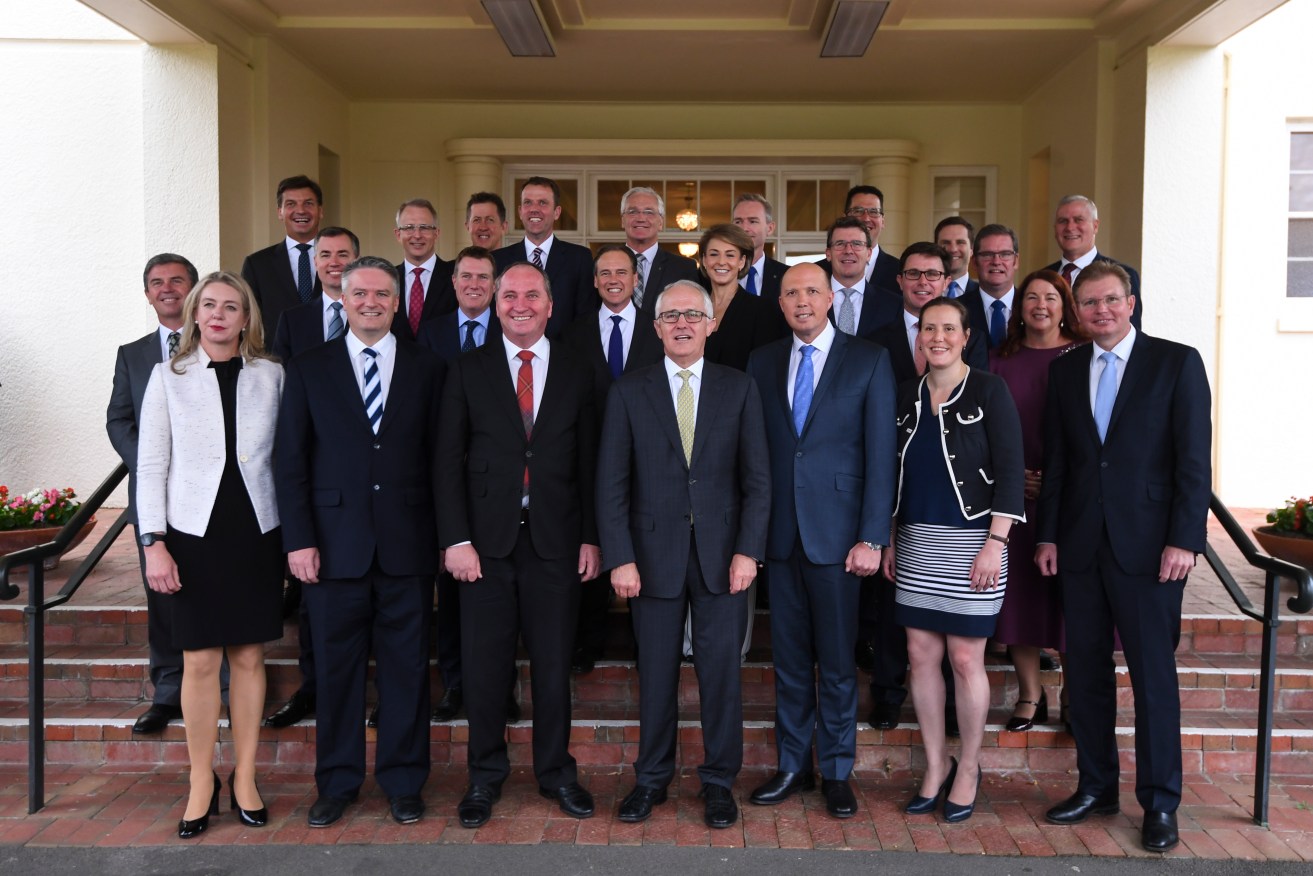Why is the gender imbalance so hard to budge?
Talking about equity hasn’t fixed the gender imbalance in our parliaments and boardrooms – now we need “pointy” targets, writes South Australia’s Equal Opportunity Commissioner Niki Vincent.


A federal Cabinet photo from last December: why are our parliaments still dominated by men? Photo: AAP/Lukas Coch
As International Women’s Day comes around again, and new statistics are wheeled out, I can’t help but think of March 8 as a day that highlights just how slowly change is really taking place in terms of gender equality in the workplace.
In fact, rather depressingly, a 2017 World Economic Forum report claims we are 217 years off reaching global parity. For the first time, we are actually going backwards because the rate of improvement has stalled significantly.
It’s hard to believe this issue can be so hard to budge. Numerous international studies have clearly demonstrated how gender diverse teams are smarter and get better results. A few CEOs are waking up to this point and are working hard now to systematically address the lack of women in the leadership pipeline, but it’s taking most businesses far too long to adapt.
If 50 per cent of the population are women, why don’t we see better gender equity in our Parliament, in senior management ranks and in our boardrooms? The fact is nothing will change unless we recognise there’s an issue that must be addressed. Just talking about the problem hasn’t helped. Now we need some very pointy targets for leaders and boards.
This is a contentious issue that few want to discuss – but we must.
Too few women at the top, do we need quotas?
Chief Executive Women conducted a survey in 2017 which found only 11 CEOs in Australia’s ASX 200 companies were women and only 21 per cent were working in senior executive positions. Figures from the Workplace Gender Equality Agency (WGEA) also show women make up only 24.9 per cent of board memberships in Australian business. This is also when there is a higher proportion of women at the lower ranks of an organisation.
Clearly, something is wrong. Women’s participation rates in the workforce have increased so why aren’t they more visible in the top jobs? If we don’t do something about it, you can hardly blame people for pushing the point and raising the issue of legislated quotas.
And why not? It’s worked in Norway, France and Spain where they demand 40 per cent of women on boards. Germany has also just introduced 30 per cent targets and increased disclosure requirements for publicly listed companies to increase women in senior leadership roles. There are some hefty consequences if these quotas aren’t met too. It seems a big stick sometimes works. But does it have to come to this?
Addressing the merit myth
In Australia, we like to see ourselves as fair and egalitarian. It’s a big part of our culture. Many are worried that with an introduction of mandated targets we will not be promoting the right people to the jobs. They fear women may not have ‘earned’ the roles, but rather they will just be making up the numbers. Worse still, perhaps men will lose their jobs as a result of getting more women on board?
None of this is factual. The notion of evaluating candidates for promotion based on ‘merit’ is not objective at all and that’s because merit itself is a social construct.
What’s seen as merit depends on who is exerting the power and influence. In unconscious ‘group think’ (remember 85 per cent of the decision-makers are usually men) we’re affected by gender stereotyping and bias. Even though we don’t always know it, it’s part of our DNA to want to work with people who look, work and think like us. It’s just an evolutionary way of creating harmony and cohesion.
In fact, there’s a whole set of ingrained beliefs that go along with the evaluation of abilities and competencies of men and women that have nothing to do with the person standing before the interview panel.
This is backed up by research conducted by Bain & Company and Chief Executive Women that found senior men in Australian business were twice as likely to rank other men over women as effective problem-solvers, despite believing that women were just as capable as men in delivering outcomes.
We can see how this would be a problem for women who are trying to break into male-dominated leadership circles. It also accounts for some of the reasons why women are so poorly represented in the most senior ranks.
Gender diversity brings rewards for all businesses
To solve the problem gender diversity needs to move from the ‘aspirational list’ to become a business priority. This means setting targets that are documented, measured and reported on. And, as leaders drive change in organisations, chief executives should have equity targets included as key performance indicators in their reviews which are linked to remuneration.
While these ideas might strike fear through the hearts of many, implementing formal mandated targets will provide opportunities for better performance. They can kickstart an evaluation of hiring and retention practices, bring in more flexible approaches to work structure, open a bigger talent pool, foster innovation, and trigger a rethink on leadership training and succession planning.
Every industry, profession and organisation is different. You don’t have to be a listed company to see the benefits of gender equity in your workforce.
The SA Chiefs for Gender Equity group has prepared a framework to help small-to-medium businesses tailor targets to meet their needs and to focus new initiatives. Local members like Westpac, BHP and Deloitte have provided their expertise, laying out clear examples that can be adapted to all stages of development. I’d urge local businesses to download a copy.
Essentially, we need more leaders to see gender equity as a key business driver, not a buzz word. Getting more women into senior leadership positions where they can participate in the decision-making process is important from both a commercial and human rights point of view.
In a developed country like Australia, women should be equally visible across all industries at the highest levels. If we don’t see real progress soon, we may have to look at tougher government measures to force the point. There are no more excuses: to build a stronger economy we need action, not promises. Let’s start today.
Dr Niki Vincent is the Commissioner for Equal Opportunity in South Australia and the convenor of the SA Chiefs for Gender Equity group. A copy of the Chiefs’ Accountability Framework ‘What gets measured gets done’ is available for download here.




